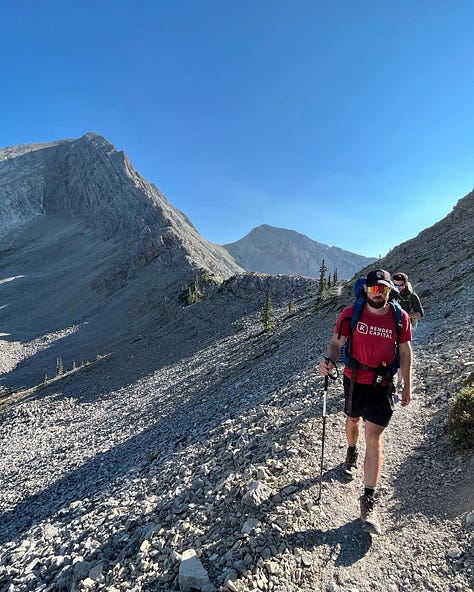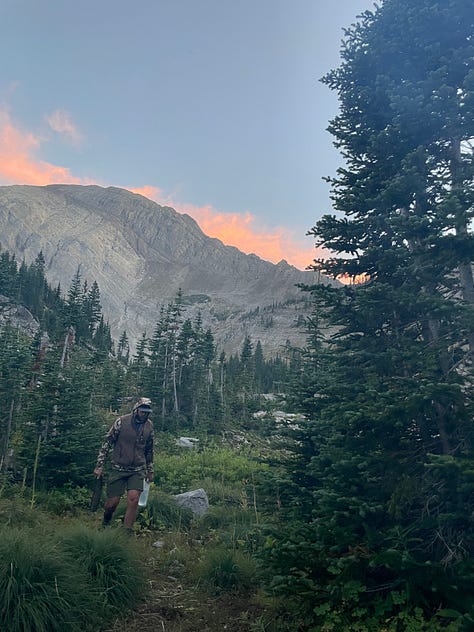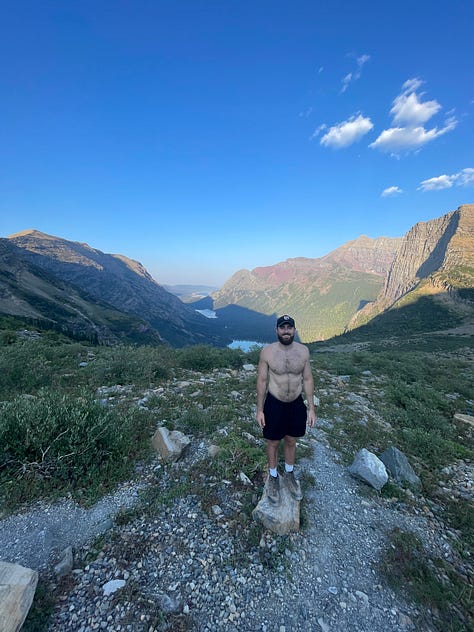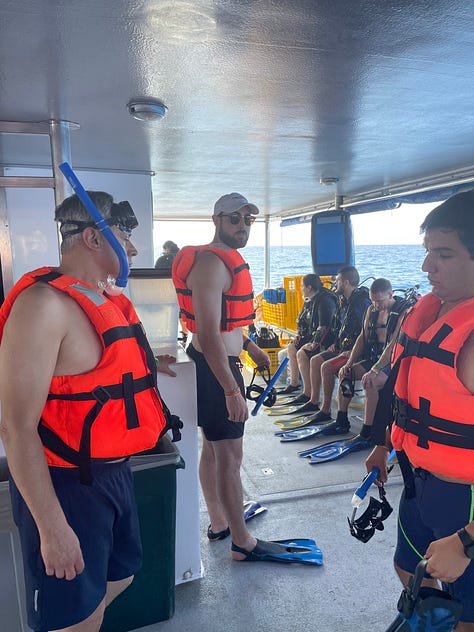Reflections on the Last Three Years of Building a Startup
The startup journey of a proptech founder in Kentucky from zero to exit.
Disclaimer: Due to confidentiality related to our acquisition, I can’t use my startup’s brand in this reflection.
Man, it’s been a wild journey the last several years, but the latest chapter of my startup career is coming to a bittersweet ending. Bitter because we didn’t reach our goals. Sweet because we built a brand and a product that someone was willing to acquire and continue to build into the future.
I believe it is important for entrepreneurs to share their learnings and failures along the way in order to help each other on our journeys. Building a company from scratch is so hard that I would hate to have gone through the experience and not pass my learnings along to others that have decided to take the leap as well.
I think it’s also an important exercise to reflect and document the journey. Challenging yourself to write about an experience and the emotions that go along with it makes it easier to go deep and really draw out learnings to apply on the next one.
Building a startup has given me every emotion possible. It’s challenged me like I didn’t know I could be challenged. I went through periods of stress and anxiety during which I lost significant weight. I’ve felt the highs of winning major contracts. I’ve felt betrayed. I’ve felt my tolerance for stress increase substantially. I’ve felt shame and the disappointment that comes with losing hundreds of thousands of investor dollars. I felt the pride that comes along with building an amazing team and a valuable product. Most importantly, I’ve learned more than I could have ever imagined.
It’s really difficult to concisely share what it’s like being a venture-backed founder and everything that goes along with that but I’m gonna do my best to explain as much of the journey as possible so others can learn from my mistakes, have more empathy for founders, and hopefully be inspired to give it a try themselves.
I dive into the details about:
The origin and early days of getting the company off the ground
Raising venture capital as a startup in middle America
Go-to-market and product learnings
The learnings I had from being deeply engaged within the proptech space
My struggles with mental health
What I’m tinkering with next
So here we go.
The First and Most Important Thing to Understand… The Early Stages are an Art.
No entrepreneur knows what they are doing in the early stages. They are experimenting. It’s a highly creative act to explore problems, conceive an idea for a product or service, build an MVP, and share it with the world effectively. There are high-level concepts and patterns to follow in the early stages; however, you cannot be taught entrepreneurship or use someone else’s game plan to get through the early stages of a startup. That’s partially why I love it so much. It’s art.
Given this understanding, all the lessons and details in my latest journey might not apply to everyone so I’ll do my best to frame them as high-level learnings and experiments. I will also be extremely transparent about our failures. I wish there was a library of failures other founders have experienced so I can read them. You can learn so fast through failure and I’d love to contribute to someone else’s learning by sharing our failures and tough lessons.
Founding Story and Pre-seed Fundraising Experience
The company was born out of a simple frustration I had managing my rental properties… tenant communication. I hated that my tenants had my personal phone number and wanted a way to efficiently manage my properties from my phone. To solve for this, we set out to build a communication platform for DIY landlords. When we took this product to market, we leveraged my co-founder Ryan Harris’s connections to Realtors to vet the idea. Many Realtor’s also own property, have property management companies, or could provide us intros to our target audience. After many customer discovery calls, the conversations often led to them telling us they wanted a similar solution for their real estate brokerage. We realized there was a desire for better, mobile-first software for agents to manage their clients. We could have kept going down the original path but we felt we had enough data telling us that path was not desired. Landlords also often told us they did not want an easier way to talk to tenants because they actually wanted to talk to their tenants less. Realtors wanted to communicate more with their clients and clearly lacked quality software to do so.
After listening to the market, we pivoted to a mobile-first CRM for Realtors. At this point we had still not raised any money and were bootstrapping. I did not want to raise money until we had something I felt people would be willing to pay for. We launched an amazing mobile-first CRM that agents were really enjoying but we knew there was more to be done in order to truly differentiate. We aggressively gathered feedback from users. We scheduled as many calls as we could and recorded all of them in order to gather data around what users wanted next.
There was a portion of our platform that showed agents their sales pipeline and commission projections and we realized that this was their favorite feature. When we asked why, they said it gave them transparency into their finances like never before from their pocket. Then it hit us... Our vision became building a vertical fintech platform for Realtors that combined their sales transaction data and their banking. For the first time, an agent could view and manage the complete picture of their business health in one place. Agents are 1099 contractors and 100% commission paid so managing their business health is a huge struggle for them.
Once we had this new direction, I saw an opportunity, created a plan, and then went out to raise a pre-seed round of funding. It took me 6-8mo to raise $300,000 in the Kentucky region and I wasn’t sure we were going to get to our goal. Then I got connected to the coastal VCs thanks to my good friend Nico Ferreyra. Once I got plugged in, we raised $300,000 in 3 weeks. We got our round done and we were off to the races.
Here’s the deal with raising money in middle America…
Many angel investors (most) do not have experience in technology, high growth, venture style investments. They have built wealth in very old school legacy industries and now want more risk and excitement in their financial lives. Because of this, some of them will beat you up on things that do not matter in the long run and should not be a concern in the very early stages. A scary percentage of investors I talked to did not know what a SAFE is or choose not to use them for various reasons.
Unfortunately, founders have to take what we can get so we end up having to engage investors like this. It slows us down and dampens our optimism from the very beginning. Many of these investors do not want to give us the terms we should be getting because we are “In Kentucky.” Because of how little capital there is in this region, investors choose to leverage this by ignoring market valuations. The market is the market and valuations are what you can get but geography no longer matters in the grand scheme of things. Great companies are being built everywhere around the world and some have zero office space. My mistake was not getting to the coasts sooner to expand my options. Next time will different.
There are great, pragmatic founders in Kentucky and middle America but there is not the local capital to back them and allow a cycle of failure and learning like there is on the coasts. This causes our ecosystems to naturally grow MUCH slower. We need founders aggressively raising capital, building, failing, winning, liquidating, and repeating before we see exciting growth. We have a VERY long way to go. That culture does not exist here unfortunately.
Investors… have empathy for founders in middle America on this front and understand that just because they don’t know your lingo or present themselves as well as coastal startup founders, that doesn’t mean they will not be able to work hard and figure it out like everyone else. As a group, we just need more shots on goal. It always astonishes me how much startups and innovation are embedded into the culture of Silicon Valley. That’s not how it is here but that doesn’t mean we have worse ideas and less capable people.
Founders in middle America are built different. We have a deep lean towards family and valuing the idea of “home” and desire to stay close to home while making other people feel at home. These values lead to a different type of grit, loyalty, and collaboration than you see on the coasts. It’s not that people on the coasts don’t have these traits but it’s built into our DNA here.
Fundraising Learnings
Have a deep understanding of what you need. We did not raise enough capital to take a fair shot at our vision. I classified our first round as a pre-seed round and I think that was a mistake. Before we raised any money, our team had done an amazing job bootstrapping a great product to market with happy users and we had a go-to-market plan we thought would work. Those items are typically done and de-risked using funds from a pre-seed round. I should have raised much more and called the round a “Seed Round.” This would have given us the proper runway and technical talent to experiment and execute on the go-to-market plan more effectively. Founders… I suggest thinking in terms of milestones and de-risking the business. Identify milestones and aspects of your company that need to be de-risked. Then, use venture to strategically knock those items off your list. Match that list to what investors expect in each funding round so goals, expectations, and your balance sheet are always aligned. Our balance sheet did not line up with the lift it takes to tackle the brokerage and MLS market.
Closely Examine the TAM and market you are going after. Founders are notorious for being overly optimistic. Its our job actually… BUT you still have to be brutally honest and audit that optimism. Founders, do yourself a favor and examine comparable companies and their exits in your industry prior to raising money. It might cause you to build the company differently or maybe not at all.
Keep investors updated on progress. As I built the company and subsequently raised money from investors, I made sure to keep them all updated with an email newsletter. Even those that did not invest in us were on the email list. I updated them just about every month with details on growth, money in the bank, team updates, product updates, challenges and needs. Investors were able to give me advice or make the intros I needed. On the next one, I certainly plan to do this again and be even more frequent with it.
The second you raise that first round, the clock starts and you’re on a roller coaster until you are forced off or you get that big win. When you raise venture capital, you are committing to investors that you are going to run as hard and fast as you can towards a goal that makes everyone a lot of money. There is no being conservative if you are truly taking your fiduciary duty seriously. Yes, your job is to build a profitable business, but no one wants a small profitable business when you get in bed with VCs. You have to understand the game you sign up for and go as big as you responsibly can. The feeling of having 18 months to produce results and reach those milestones that allow you to raise that next round or become profitable is wild. It’s a thrill and a risk but it’s stressful. Founders… understand what you are signing up for. Venture might not be the best route for your business so don’t do it until you know its what you need and you’re ready for that pressure and timeline. Some people just aren’t built for it.
Team Building Struggles
I believe the hardest but most important part of building a startup is building the right team. We built an amazing team and the product/brand we built prior to the acquisition was impressive; however, it was a major struggle getting to a point where we were firing at all cylinders. It took us about 2 years until we had the team to get the job done.
When we founded the company, we had four co-founders. All of us were extremely talented and experienced in our given domains and our team was one of the primary reasons we were able to raise VC money. Once the team was assembled, we got to work talking to customers, building prototypes, and doing customer discovery for go-to-market strategy, and eventually, we started raising our pre-seed round. We were hitting a great stride but were blindsided when our technical co-founder decided he no longer wanted to be on the team. It was a very frustrating and messy situation but it was ultimately out of our control. He simply wasn’t ready to be a founder and we had to quickly find a solution. Unfortunately, his exit could not have come at a worse time.
All of this happened when developer demand was at an all-time high and we were in the middle of our fundraise. Development came to a full stop and we ended up temporarily using a development agency that was referred to us by a friend to fill the gap while we looked for a new developer to join the team. The agency was an absolute disaster. It could not have gone any worse and we were essentially scammed out of $75k and decided not to use any of their code. Again, we were stuck in an extremely difficult position and had to get out of it as quickly as possible.
Luckily, our co-founder Tanner Wilcox knew someone he had worked with on several projects and that was John Arstingstall. He had 10 years of startup experience, had been a major part of three exits, led teams, and was a full stack developer. John was exactly who we needed to join the team and we were blessed to land him because we wouldn’t have gotten as far as we did without him. About the same time we landed John, we also finished the pre-seed round. We had about $500,000 in the bank and were off to the races but the struggles to hire development talent didn’t stop there.
With the funds, we wanted to hire another developer to support John. Again, this was peak demand for development talent and this was during the transition to remote work for everyone so it was extremely challenging. Two of the developers we ended up bringing on the team were working multiple jobs without telling us. Luckily, we caught it before we wasted too much money on them. Eventually, John managed to bring two developers he’s worked with previously on as contractors and we finally had some stability. Once we got to that point of stability, it was magic and I stopped needing to worry about talent or product development struggles. Ultimately, our team built an amazing product we’re all extremely proud of.
Learnings Building a Team
Don’t settle. Find people that want to get in the trenches and grind alongside you. Find extremely talented and driven individuals. Don’t settle for anything less and move on when someone doesn’t fit. Building a startup is extremely difficult and if someone isn’t cut out for the task, they are fat that needs to be trimmed. Yes, people and relationships are absolutely essential, but there is no room to be too emotional. You have to be absolutely relentless in finding excellence in that early team. The right people will respect that relentlessness and desire for nothing but the best. Why would talented people want anything less? There were times I could have been more ruthless and relentless.
Find complimentary skills rather than people that are similar to you. Ryan, Tanner, and John all brought something unique to the team and it showed in the speed were were able to execute, the quality of the product, the polished brand, and overall user experience. The whole team has to be willing to share their unique perspective and everyone has to be self-aware and open enough to listen and iterate on themselves.
Everyone has to be transparent. There is no time or room to hide anything. The stakes are too high to not be completely open and blunt with your co-founders and stakeholders. Things break down and teams fall apart when there is confusion about commitment. When there is a culture where people can’t be transparent about their ideas, emotions, and commitment, you are due for pain and failure. When our co-founder blindsided us and quit, it was an extremely large blow that could have been mitigated if communication was better.
I think a six year vesting schedule is the way to go for co-founders. Four years is an extremely short period of time in the grand scheme of things. By moving the full vesting out two years, I believe you better align with the realistic timeline of a business. If you are truly about it, you won’t care if it’s four years or six years.
If you can, bring design talent onto the team as a co-founder or as early as you can. They speed things up significantly and bring a sense of cohesion to the chaos. This is especially true if you are building a B2B horizontal product or B2C product. Being able to design, build, get feedback, and iterate on a product rapidly and effectively is a million times easier when you have a professional designer there to see the full picture while also paying attention to the small details. If you can find that person, do everything you can to make them feel valued as a major contributor. Tanner was the glue that held our team, brand, and product together. No doubt about that.
Product Development and Go-to-Market Learnings
Do to confidentiality related to the acquisition, I can’t share many details on this front, but I can share high level learnings that I think could be useful for other founders…
Develop your go to market earlier in the company journey and have deep understanding of all the market dynamics. I did not have a complete understanding of the MLS landscape when we started and I would have done a ton of things differently. Although, looking back… One of the MAJOR problems with this space is that it is an inside ballgame. These answers live behind consultants and bar tabs at conferences. There is zero documentation or content being created to educate founders on how they should navigate the space.
The reason you closely tie go-to-market and product as early as possible is so you can build a very specific set of features for a very specific group of users you think are the lowest hanging fruit to sell into. Just make features for them. If you try to build something that works for everyone right out of the gate, you will struggle to build something great for anyone and thus have trouble finding the best go-to-market path. Test one thesis at a time for a niche user and expand from there.
If you enter a niche industry that is extremely complex and you don’t already have deep domain experience in it, find a consultant/advisor to hold your hand as early as you can. This was the case for us in the MLS market. We brought an advisor on the team to help us navigate but it was frankly too late. They did a great job opening doors, but ideally, they would have been involved earlier in order to help with strategy and product development. The best case is you have a founder that deeply understands the space and is well networked within it, but again, the MLS industry is an extremely tight circle.
Test customer acquisition cost (CAC) early and often. When you find something that works, grind on it. Until you find it, do your best to test everything you can and use as much data as you can to efficiently allocate funds. Test your paid ad channels, content channels, copy, landing page, onboarding, payments page, EVERYTHING. Don’t get emotional about it. It’s a math equation and you have to treat it as such. One way to speed this process up and direct funds intelligently is ask potential customers where they discover new products and how they like to purchase them. Based on what they say, focus on the most common channels and build your funnel to support their ideal onboarding experience. The best is word of mouth.
Have people on the early team willing to be a hacker and grind on experimentation. Growth is hard to find and is often a surprise when it is found. Typically it follows product market fit, but could come pre-maturely… You have to stay up to date with trends, try a ton of things, use a ton of tools, and learn extremely fast. Hackers are always looking for efficient ways to penetrate a system so I think having a “growth hacker” mentality is important to have on the early team. Ryan was consistently that guy and it was super impressive watching him learn and find creative tactics for getting in front of real estate agents. Unfortunately the math never worked out.
Proptech Learnings
Proptech is HARD. Very few companies reach an exit deemed VC worthy. Below are some reasons:
It is extremely fragmented and local. Real estate is local. Plain and simple. You cannot scale most products on a national level without going from one market to another sequentially. This is because of how dependent every stakeholder in the space is to local home prices, trends, climate, regulations, and consumer preferences. It’s also because of the fragmented MLS and association landscape. This fragmentation is a beautiful thing on a macro level for our economy and housing markets but makes it extremely hard on founders to scale.
Real estate is extremely human. Transactions in the space are very large and people lean on their trust in one another heavily. If you are thinking of launching a business that replaces the need for a real estate agent… don’t bother. It’s not gonna happen. 90% of consumers work with an agent and that has consistently gone up over the years despite many advances in technology. If you think agents are replaceable, you probably fall into two camps…
You regularly deal with large transactions and are familiar with the risks. This means you are a VERY small percentage of consumers when it comes to buying a home. Because of your high sophistication in transactions, you do not understand the average consumer who wants an agent.
You don’t know what you are talking about.
Scaling is wildly expensive and takes a very long time. If you want to find a sustainable GTM plan, you almost have to be selling leads to agents or go through the association and MLS network. This is because associations and MLSs have a captured user base that depends on their aggregated listing data to function. For those that don’t know, the MLS network is the data layer of the residential real estate industry. All the transactions that take place are recorded on the MLS. It promotes collaboration and compensation in the marketplace. Before the internet, brokers wanted to give their clients the best experience possible so they put as many active listings as they could in a big book to present their clients. Then all the brokers started sharing their books with each other so their listings could get more reach and eyeballs. Then the internet came along and these listings got put into a regional database for the brokers to view and put on their websites. HOWEVER, when this happened, each regional MLS (700+ of them) built their own database with different data schema, different technologies, and different governance. The lack of standards and fragmentation has made technology adoption pretty much impossible at scale without tens/hundreds of millions of dollars or YEARS of runway and patience. In many ways, that is still the case today; however, there are some great efforts by organizations like RESO (Real Estate Standard Organization) to fix this problem.
There is very high churn if you are selling to agents. Agents are entrepreneurs in their own right. They are all operating as independent contractors and naturally there is a very high churn rate within the industry. This trickles down to the vendors they use to run their business. You can count on 25% - 40% natural churn.
Due to the above, private equity is extremely active and dominates the space from a technology perspective. You have Zillow and then all the PE firms that buy products, consolidate them, and push them through their existing distribution. VC just doesn’t map well to this space at all because of the timing to get to market and TAM.
TAM is not equal to the number of agents multiplied by the cost of a product. ~40% of the agents in the space do no business at all and about 15% of them do 90%+ of the business. Founders, do not put the total agent count on your pitch deck as your TAM. You are lying. I did it… and now laugh at myself.
Unless you are already an insider, align yourself with insiders as quickly as you can. Bill Fowler was absolutely massive in our strategy and GTM. Again, the industry is extremely opaque and an insiders ballgame.
Do yourself a favor if you are interested in proptech by studying Real Estate Standards Organization (RESO) and get connected to their network. They are the single most important organization in the entire industry. You will get more value out of that network and their information than anywhere else you can look. Their conferences are a must if you are building any kind of technology that could leverage MLS data or distribution.
The Acquisition
After tough lessons in go-to-market and the MLS landscape, we tried one last ditch effort to build a version of the product that could be sold into teams and small brokerages. We showed promise with a few customers but ultimately not enough to continue raising money responsibly. We did a small bridge round but I think every founder should be very thoughtful about continuing to raise money vs selling, or failing and moving on. I never want to be a founder that continues to build something when I should instead be self aware, accept defeat, and figure out a responsible way to move on. We ultimately decided after three years of trying everything we could, it would be best to find a new home for our technology and brand. Luckily, I had been building many relationships in the space and I knew there would be a good amount of interest in acquiring the company.
We needed to find someone with established distribution and MLS data integrations across the country. We found that and sold the business to a wonderful company that will take the company into its next phase. I’m by no means celebrating but I’m proud of what we’ve built and excited to see where it goes from here. Having the opportunity to return capital to investors makes the defeat a little easier to swallow.
The acquisition went extremely smoothly thanks to a few things:
On day one, we got a great attorney that set us up with all the docs we needed. Attorneys seem expensive but they are cheap if you actually think about the alternative of not having one and then having co-founder disputes, lawsuits, data privacy issues, or missed transactions because you don’t have the right legal docs in place. The peace of mind is worth it alone.
We built a brand and product with customers in mind from day one and made sure we provided customers and the industry with value. If you do something different enough that people find valuable, there will usually be a buyer.
I engaged the ecosystem and had a buyer before we actually went to market to be purchased. I met our buyer a year prior.
I spent the time to keep our finances in check. I’m by no means an accountant, but I spent enough time on it that it didn’t present too many issues. It wasn’t perfect but it got the job done. I’ll get an accountant next time though…
Again, I’m so proud of our team. We rolled with the punches like champs, we iterated on product at an extremely fast pace, we tested every go-to-market path possible, and we all had fun while doing it. We just couldn’t figure it out and that sucks.
The feelings of pain, failure, anger and everything in between led me to look inward over the last several months and that’s the other side of the journey… mental health.
The Mental Health Struggles
After putting so much effort into something as hard as starting a company from scratch, it takes a serious toll. I only became aware of the toll it was taking on me when I realized we weren’t going to reach our goals. I wish I was more self aware of the negative effects earlier but there was something about my company struggling that made me look inward. I placed too much of my identity and mental energy into building companies while other areas of my life were struggling. It’s in my personality to obsess over something and see things to their end and I’ve been running hard at building startups since I dropped out of college to build Fooji. All of the negatives that come along with this lifestyle had been building internally and finally hit me all at once. It’s been very painful but I’m glad I’m being challenged, learning, and growing. I can feel the growth and I hope sharing these struggles help other entrepreneurs find some assurance they aren’t alone because the more you open up to other entrepreneurs the more you realize these aren’t unique struggles. We all voluntarily subject ourselves to the mental beatings and stress but we all cope with it in different ways so it’s hard to talk about.
Personal Identity and Being Present
Building companies became my passion and professional identity in college. I did it for the first time my freshman year and I fell in love. I went all in and dropped out of college before my junior year for Fooji where I thrived in an environment my work directly affected the success of the company. On top of that, I was making a lot of money for a 20 year old. Making something out of nothing was a drug. It was my art and my way of expressing myself.
When you combine my love for building and just under a million dollars of VC funding that I raised to build the company, I’d estimate 90%+ of my mental energy each day was being spent on work. It’s extremely hard to shut off and it took a toll on my relationships, friendships, and hairline. I could feel myself being checked out and struggling to be present or fulfilled with what was right in front of me. I was constantly thinking about problems or what came next on my to-do list. As CEO, it’s my job to tackle the biggest problems and it takes up the majority of my time.
Aside from my mental energy being sucked up, my identity was tightly wrapped into my work as well. From FinanceU, to Fooji, to real estate investing, to Middle Tech, I leaned too far into work as my identity so when the company started to fall apart, I started to question my identity. I had to constantly remind myself that work is not my identity but that’s hard when you enjoy it so much. One thing that I’ve come to understand is that when you build a startup, the early days are a series of creative experiments in search of promising data. Framing it like that has been a huge help. Sometimes (a lot to the time) the data doesn’t come back promising, but you gotta keep experimenting. It’s not your identity you’re experimenting with, it’s a company and a product.
Toll on Relationships
When you spend too much time focusing on work and the ups and downs that come along with a startup, relationships struggle. It’s a constant battle between work, family, friends, and dating/marriage. It’s hard to show up… As a founder, you get told no 99% of the time. It can make you cold. Getting told no a million times a week made me lack the ability to empathize as much as I should with other people’s struggles and emotions. I spent all day and night dealing with no’s/problems and didn’t want to think about anyone else’s. I’ve been extremely selfish and it sucks to see some of those effects looking back on relationships and people I love, but I’m glad I know what I need to work on going forward. You can’t avoid some of this stuff as a founder but you can make a conscious effort to not bring it home with you after you finish working.
I’m a very quiet and composed person that historically has had a sense of pride in the idea I seem to be in control of life. However, the reality was I was not in control as much as I liked to think. I wanted to extend my constant need to use logic to solve problems to everything else in life… and that’s not healthy. Especially in relationships. There are things in life that make absolutely zero sense and when you overthink them or try to view them through the lense of problem solving, you screw them up. You can’t control people’s emotions, you can’t treat them like a problem to solve, and you can’t write them off when you are tired of dealing with problems. You gotta show up and put in just as much/more energy into them as you do your company. Looking back, this is by far where most of my regret lies.
Addictions
Entrepreneurship is a perfect breeding ground for addiction. We voluntarily expose ourselves to extreme and constant stress which often times is so overwhelming that we have to find ways to get away and make it less acute. It’s easy to lean into nicotine, drugs, porn, caffeine, food, social media, alcohol, or even more work. It can be hard to find things to reduce stress that are healthy but you gotta try because that stress isn’t going away and if you get rid of one addiction, there will be another one right around the corner. Over the last year or so, I started to notice my addictive behaviors and their origins so I have been working hard to replace them the with healthier habits that take my mind and time away from work. I’ve started running 10-15 miles a week, I’ve done better controlling my screen time, and I’ve challenged myself to get better at hobbies like golf.
Founders, audit what your tendencies are when you feel stressed. You can’t eliminate the stress or the need to dampen the blow, but you can control what you do when it hits you. If you aren’t proud of what you do in that moment of stress, work to replace it with something or find support before it becomes a bigger problem. The best replacement to negative habits I’ve found is physical activity. Go to the gym, go on a run or a walk, do some pushups, do something that is proven to reduce stress while also being productive and healthy.
Being Closed Off
It wasn’t until I got a therapist that I realized how good it felt to share what I’m going through with other people openly. Again, I’m naturally very quiet and composed but that doesn’t mean I don’t have a lot going on that I’m struggling with. It’s pretty lonely being an entrepreneur because each company is so unique and very few people choose to build a company, especially one that is VC backed in Kentucky. This makes it hard to open up about your struggles so its easy to keep it bottled up. When you keep the work related stuff in, it’s easy to keep everything else in as well. Again, this makes relationships hard. You’re willing to put a product out there and eagerly seek feedback but it’s hard to do the same with yourself. It’s not possible to have healthy relationships when that is the case.
I’ve been blessed and have built a strong community of founders around me but this is still a huge struggle because we are all busy. Working with a therapist has been a huge help and I’ve found it makes it easier to open up to everyone else as well. I encourage founders to surround themselves with other founders willing to share their feelings. I also recommend getting a therapist. I wish I did it earlier.
Faith
All of these things have made me realize I need to grow in my faith. I’ve done a poor job practicing my faith since I left home for college. It’s hard to develop a strong faith as a rebellious founder. Having faith and trusting God has a plan is hard when you are paid to make something from nothing while having an extreme sense of ownership, pride, and control. Your ego can get in the way and make you think you can handle it all yourself. At times I thought I was God but of course, that was only when times were good.
Sometimes I used faith to simply check a box or solve a problem. Sometimes I avoided it all together. Other times I just got lazy or simply didn’t prioritize it. I grew up with faith being a huge part of my life going to catholic schools and I believe that you have to leave your faith in order to realize why it needs to be important in the first place and you have to make it your own. One thing that did help in tough times was having a sense of gratitude for the things in life I’ve been blessed with.
The way I look at it is… I’ve been blessed with talents and circumstances in life that have afforded me the ability, and the will, to subject myself to extreme challenges and stress in pursuit of creating value for other people.
It’s so hard but also fun… I can’t imagine doing it simply for my ego and some money. That seems like a sick and sad existence. I’ve been blessed and I want to make the most of it.
Why its All Worth It
For me, I simply can’t do anything else… or at least not for too long. I’ve always done things my own way, explored, and built things. It’s all worth it because I have a ton of fun challenging myself to learn about and create things that provide people value. It’s an itch that I can’t get rid of.
Other than it being part of my personality, its extremely fulfilling for a few more reasons:
Building a team of talented people to tackle a problem together is a blast. Collaborating and solving problems with people you believe in and vice versa is something I hope everyone can experience.
Learning velocity is absolutely insane. If you are someone that loves to learn, there is absolutely no better way than to build a product or service and take it to market in the field you want to study. I promise you… it’s impossible to learn faster than building startups. It’s a forcing mechanism.
Making sales is intoxicating. When someone is willing to give you money because you solve their problem, that feeling is hard to match professionally. It’s different for founders because we get to see all the work it takes from idea to happy customer. Knowing how hard that journey is and the difference you make for them is huge.
Freedom and autonomy… I am not a fan of authority in most circumstances. That’s gotten me in trouble in more traditional settings. I was constantly getting in trouble in school growing up and I hated college. It’s nice to be paid for being different and rebellious as an entrepreneur.
Perspective on adversity and failure
I wouldn’t classify the startup as a failure, but we definitely didn’t reach our target as a team. That hurts. There is no way around that hurt, but you have to use it to learn and fuel your motivation for the next one. Nothing ever goes as planned so embrace that. I think I thrive in chaos and uncertainty. Adversity and failure is just a piece of that.
Reminder: Why Did I Share All of This?
We need more storytelling in Kentucky… Kentucky needs more founders to step up and be public about their journey so others have the confidence to follow in their footsteps. There is hardly a startup culture here and the only way to change that is for more people to set an example. Even if it doesn’t work out as planned, at least others can see its possible and something worth pursuing.
Founder mental health needs way more attention. The more people that speak up about founder mental health, the more help we will all get collectively. We will at least know we aren’t alone. Sometimes, that’s enough.
What’s Next
When I saw the end coming and all that stress, pain, and shame were at their peak, I told myself I couldn’t go back to working on another startup right away and I should get a normal job for a while… That feeling lasted about two weeks.
However, despite getting the urge to start working on something new immediately… I have made sure to take time to reflect, recharge, and do some exploring. With the time I’ve had, I started traveling the world while a friend and I were researching and tinkering with generative AI.
I like to travel to unfamiliar places between major life events because it is forced culture shock. Being in new places forces you to be in the moment and take everything in around you. This is extremely therapeutic for me. You can’t climb a mountain while thinking about your startup. You can’t navigate through the crowded markets of Bangkok and think about your failures.









What I’m tinkering with:
I was excited to start playing with Generative AI and LLMs. I got early access when OpenAI launched their playground, I immediately purchased ChatGPT Plus, and ever since the launch of the technology, I have been heads down researching the latest developments and watching people’s behavior. It’s been very clear to me that this is the real deal. This is a new platform that will change everything and businesses that do not adopt it quickly will be overtaken by competitors that do.
It’s been interesting watching the market explode and study what the first movers are doing. It’s still so early but I believe many companies being funded have built commodities because they view LLMs as the primary feature of their product without having access to proprietary data or building around a specific workflow. In my opinion, LLMs are just A SINGLE PIECE of a SaaS product’s overall architecture. You must still build valuable workflows that generate proprietary data (ideally net new data) that is uniquely valuable thanks to LLMs.
I have extremely high conviction that there is a MASSIVE opportunity to build a collaboration/productivity product that allows teams to make rapid, asynchronous decisions that are more informed and impactful than ever before. LLMs are a perfect technology for collaboration. Most collaboration products revolve around sharing some kind of context. LLMs are context sponges.
Personally, I have noticed two major pain points that need to be addressed…
The problem #1: Remote/hybrid work has challenged our familiar ways of doing business. We’ve desperately needed a new technology that empowers teams to work more asynchronously and connect the dot between their decisions and KPIs so employees feel what they are doing moves the needle. The problem with async is sharing context and KPIs with each other is hard and fragmented, so we’ve defaulted to setting stand-ups and zoom meetings to share context and KPIs in order to make decisions. This is a drag and slows things down drastically. There is also a lack of energy and ownership around progressing KPIs when a company is distributed compared to in-person work. This makes it easy for a company to struggle with alignment. As a result, culture gets crushed. LLMs can be used to solve this pain point.
Problem #2: AI experiences are not collaborative. When employees within a business use ChatGPT or other tools, they cannot use them together which prevents a lot of the benefit of AI from being captured. Right now, businesses are not using ChatGPT... individuals are. That needs to change. I used ChatGPT heavily in most of my business decision making and absolutely saw massive benefits. In the near future, if people are not using AI to help inform their decisions, they cannot be taken seriously. We must build tools that make it easy for entire teams to collaborate with AI models in an environment purpose built for decision workflows. This will require brand new architectures and content management strategies (RAG.)
I acutely felt these problems building my last company and my co-founder experienced them as a developer inside massive, bureaucratic organizations with sensitive financial and healthcare data.
I haven’t seen many compelling enterprise plays with LLMs yet beyond co-pilots and search but that will change. It’s still the early days but I think we have a very unique application of the technology that solves really big problems.
It’s super cool and we’re calling it Devyze. We already have an MVP we are testing internally. Soon, we will invite a few select design partners and pilot programs!
If you are a business leader that wants your team to adopt AI in more of their workflows, please reach out. I’m very excited because we’ve gotten amazing feedback so far.
To close, I hope my learnings are helpful for others taking that leap into the startup world. It’s unbelievably difficult but its worth it. I’d love to see more people in Kentucky taking that risk. That’s the only way our state will grow.





